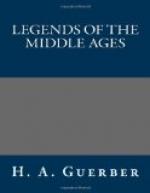[Sidenote: The champion of Christianity.] As Charlemagne destroyed the Irminsul, razed heathen temples and groves, abolished the Odinic and Druidic forms of worship, conquered the Lombards at the request of the Pope, and defeated the Saracens in Spain, he naturally became the champion of Christianity in the chronicles of his day. All the heroic actions of his predecessors (such as Charles Martel) were soon attributed to him, and when these legends were turned into popular epics, in the tenth and eleventh centuries, he became the principal hero of France. The great deeds of his paladins, Roland, Oliver, Ogier the Dane, Renaud de Montauban, and others, also became the favorite theme of the poets, and were soon translated into every European tongue.
The Latin chronicle, falsely attributed to Bishop Turpin, Charlemagne’s prime minister, but dating from 1095, is one of the oldest versions of Charlemagne’s fabulous adventures now extant. It contains the mythical account of the battle of Roncesvalles (Vale of Thorns), told with infinite repetition and detail so as to give it an appearance of reality.
[Sidenote: Chanson de Roland.] Einhard, the son-in-law and historian of Charlemagne, records a partial defeat in the Pyrenees in 777-778, and adds that Hroudlandus was slain. From this bald statement arose the mediaeval “Chanson de Roland,” which was still sung at the battle of Hastings. The probable author of the French metrical version is Turoldus; but the poem, numbering originally four thousand lines, has gradually been lengthened, until now it includes more than forty thousand. There are early French, Latin, German, Italian, English, and Icelandic versions of the adventures of Roland, which in the fourteenth and fifteenth centuries were turned into prose, and formed the basis of the “Romans de Chevalerie,” which were popular for so many years. Numerous variations can, of course, be noted in these tales, which have been worked over again by the Italian poets Ariosto and Boiardo, and even treated by Buchanan in our day.
It would be impossible to give in this work a complete synopsis of all the chansons de gestes referring to Charlemagne and his paladins, so we will content ourselves with giving an abstract of the most noted ones and telling the legends which are found in them, which have gradually been woven around those famous names and connected with certain localities.
[Sidenote: Charlemagne and the heavenly message.] We are told that Charlemagne, having built a beautiful new palace for his use, overlooking the Rhine, was roused from his sleep during the first night he spent there by the touch of an angelic hand, and, to his utter surprise, thrice heard the heavenly messenger bid him go forth and steal. Not daring to disobey, Charlemagne stole unnoticed out of the palace, saddled his steed, and, armed cap-a-pie, started out to fulfill the angelic command.
He had not gone far when he met an unknown knight, evidently bound on the same errand. To challenge, lay his lance in rest, charge, and unhorse his opponent, was an easy matter for Charlemagne. When he learned that he had disarmed Elbegast (Alberich), the notorious highwayman, he promised to let him go free if he would only help him steal something that night.




